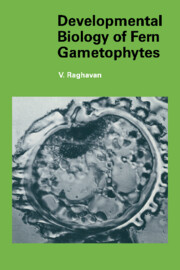Book contents
- Frontmatter
- Contents
- Preface
- Abbreviations
- 1 Introduction
- PART I THE BEGINNING
- 2 The spore – beginning of the gametophytic phase
- 3 Physiology of spore germination
- 4 Cell determination and morphogenesis during germination
- 5 Biochemical cytology and biochemistry of germination
- PART II GROWTH AND MATURATION
- PART III REPRODUCTIVE STRATEGIES
- PART IV DEVELOPMENTAL OPTIONS
- References
- Author index
- Subject index
5 - Biochemical cytology and biochemistry of germination
Published online by Cambridge University Press: 11 September 2009
- Frontmatter
- Contents
- Preface
- Abbreviations
- 1 Introduction
- PART I THE BEGINNING
- 2 The spore – beginning of the gametophytic phase
- 3 Physiology of spore germination
- 4 Cell determination and morphogenesis during germination
- 5 Biochemical cytology and biochemistry of germination
- PART II GROWTH AND MATURATION
- PART III REPRODUCTIVE STRATEGIES
- PART IV DEVELOPMENTAL OPTIONS
- References
- Author index
- Subject index
Summary
The potential of appropriately induced spores to germinate depends upon the sequential unfolding of a predetermined program of metabolic processes and regulatory mechanisms that control cell differentiation. Since germination of fern spores is accomplished in a closed system – that is, without the intake of any external nutrients, the synthetic processes must occur at the expense of the stored reserves. Thus, the first order of business of a germinating spore is hydrolysis of its storage reserves to simple compounds. Equally pressing is the need to replenish the structural proteins of the cytoplasm and the complement of enzymes required for general cellular metabolism. At the same time, a sustained biogenesis of membrane systems and organelles also occurs in the spore. Not long after these events, cell division ensues with all the complex biochemical processes it entails, including deoxyribonucleic acid (DNA) and protein synthesis and assembly of the mitotic spindle. Unlike the angiosperm seed, where major catabolic and anabolic activities during germination are segregated to morphologically different tissues, there is no conceivable division of labor between cells in the fern spore. Here, both degradative and synthetic processes preparatory to germination occur in the same cell.
This chapter is devoted to an analysis of the metabolic and synthetic activities during germination of spores of a selected number of ferns.
- Type
- Chapter
- Information
- Developmental Biology of Fern Gametophytes , pp. 83 - 104Publisher: Cambridge University PressPrint publication year: 1989

